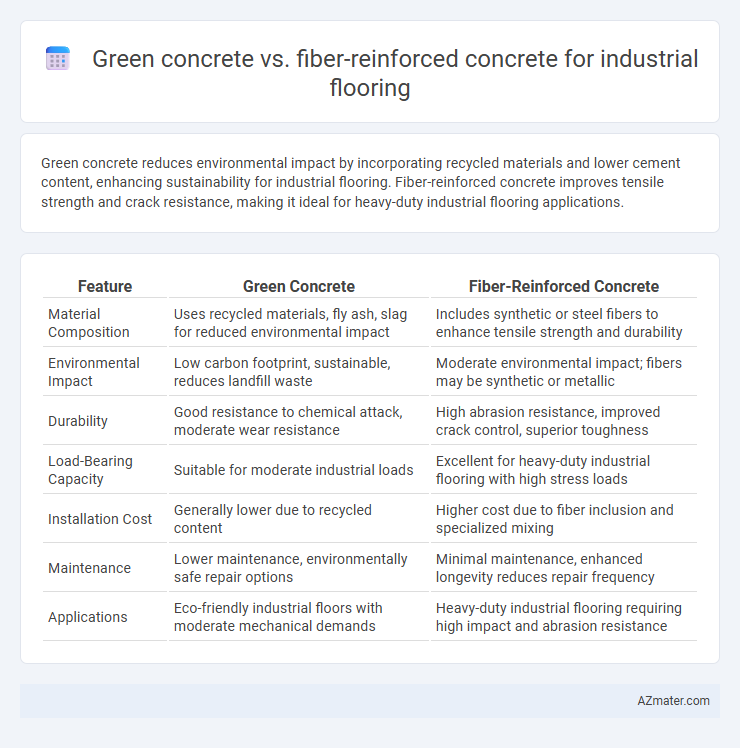Green concrete reduces environmental impact by incorporating recycled materials and lower cement content, enhancing sustainability for industrial flooring. Fiber-reinforced concrete improves tensile strength and crack resistance, making it ideal for heavy-duty industrial flooring applications.
Table of Comparison
| Feature | Green Concrete | Fiber-Reinforced Concrete |
|---|---|---|
| Material Composition | Uses recycled materials, fly ash, slag for reduced environmental impact | Includes synthetic or steel fibers to enhance tensile strength and durability |
| Environmental Impact | Low carbon footprint, sustainable, reduces landfill waste | Moderate environmental impact; fibers may be synthetic or metallic |
| Durability | Good resistance to chemical attack, moderate wear resistance | High abrasion resistance, improved crack control, superior toughness |
| Load-Bearing Capacity | Suitable for moderate industrial loads | Excellent for heavy-duty industrial flooring with high stress loads |
| Installation Cost | Generally lower due to recycled content | Higher cost due to fiber inclusion and specialized mixing |
| Maintenance | Lower maintenance, environmentally safe repair options | Minimal maintenance, enhanced longevity reduces repair frequency |
| Applications | Eco-friendly industrial floors with moderate mechanical demands | Heavy-duty industrial flooring requiring high impact and abrasion resistance |
Introduction to Industrial Flooring Needs
Industrial flooring demands high durability, load-bearing capacity, and resistance to wear and chemical exposure. Green concrete offers sustainability advantages through recycled materials and lower carbon footprints, making it suitable for eco-friendly industrial environments. Fiber-reinforced concrete enhances mechanical performance by improving tensile strength and crack resistance, ensuring longer service life under heavy industrial traffic.
What is Green Concrete?
Green concrete is an eco-friendly building material that incorporates industrial by-products like fly ash, blast furnace slag, or recycled aggregates to reduce carbon emissions and conserve natural resources. It maintains comparable strength and durability to traditional concrete while lowering environmental impact, making it ideal for sustainable industrial flooring applications. This innovative material supports green construction practices by minimizing waste and energy consumption throughout the production process.
Overview of Fiber-Reinforced Concrete
Fiber-reinforced concrete (FRC) enhances industrial flooring durability by integrating fibers such as steel, glass, or synthetic materials, which improve tensile strength, crack resistance, and impact absorption. This composition is particularly effective in high-traffic industrial environments requiring enhanced load-bearing capacity and longevity. Compared to green concrete, which emphasizes sustainability and reduced carbon footprint, FRC prioritizes mechanical performance and structural integrity for heavy-duty applications.
Raw Materials and Sustainability
Green concrete utilizes industrial by-products like fly ash, slag, and recycled aggregates, significantly reducing the carbon footprint compared to traditional cement, making it a sustainable choice for industrial flooring. Fiber-reinforced concrete incorporates synthetic or natural fibers such as polypropylene, glass, or steel, enhancing durability and crack resistance, but its environmental impact depends largely on the fiber production process. The raw material sourcing and recyclability of green concrete contribute to lower embodied energy and waste, positioning it as a more eco-friendly option for sustainable industrial flooring solutions.
Mechanical Properties and Durability
Green concrete offers enhanced sustainability with comparable compressive strength to traditional mixes, making it suitable for eco-friendly industrial flooring applications. Fiber-reinforced concrete significantly improves tensile strength, impact resistance, and crack control, contributing to greater durability under heavy machinery and dynamic loads. Both materials enhance flooring longevity, but fiber-reinforced concrete typically outperforms green concrete in flexural toughness and abrasion resistance, critical for intense industrial environments.
Environmental Impact Comparison
Green concrete significantly reduces carbon emissions by incorporating recycled materials and industrial by-products like fly ash and slag, lowering the consumption of Portland cement. Fiber-reinforced concrete enhances durability and crack resistance, decreasing maintenance frequency and material replacement over time, which indirectly minimizes environmental impact. Comparing both, green concrete offers a more sustainable lifecycle carbon footprint, while fiber-reinforced concrete contributes to longevity and resource efficiency in industrial flooring applications.
Performance in Heavy-Load Applications
Green concrete offers enhanced sustainability with moderate compressive strength suitable for heavy-load industrial flooring, while fiber-reinforced concrete provides superior tensile strength, crack resistance, and durability under high-stress conditions. In heavy-load applications, fiber-reinforced concrete outperforms green concrete by minimizing shrinkage and improving impact resistance, which extends flooring lifespan and reduces maintenance costs. Optimal industrial flooring under intense mechanical stress typically relies on fiber reinforcement to maintain structural integrity and performance.
Cost Effectiveness and Lifecycle Analysis
Green concrete offers cost-effective benefits in industrial flooring due to its use of recycled materials and lower carbon footprint, reducing long-term environmental compliance expenses. Fiber-reinforced concrete enhances durability and reduces maintenance costs by improving crack resistance and load-bearing capacity, extending the flooring lifecycle. Lifecycle analysis reveals that fiber-reinforced concrete may justify higher initial costs with reduced repair frequency, while green concrete delivers savings through sustainable material sourcing and waste reduction.
Installation and Maintenance Considerations
Green concrete for industrial flooring offers easier installation due to its use of recycled materials and lower water content, reducing curing time and minimizing shrinkage cracks. Fiber-reinforced concrete enhances durability and crack resistance, requiring specialized mixing and placement techniques to ensure even fiber distribution, which can extend installation time. Maintenance of green concrete is generally straightforward with lower susceptibility to chemical degradation, whereas fiber-reinforced concrete demands periodic inspections to monitor fiber integrity and repair micro-cracks promptly for optimal performance.
Future Trends in Industrial Flooring Solutions
Future trends in industrial flooring emphasize sustainability and durability, with green concrete gaining traction due to its reduced carbon footprint and incorporation of recycled materials. Fiber-reinforced concrete offers enhanced tensile strength and crack resistance, making it ideal for high-load industrial environments. Innovations combining eco-friendly binders with advanced fiber additives are expected to dominate next-generation industrial flooring solutions, balancing environmental impact with performance.

Infographic: Green concrete vs Fiber-reinforced concrete for Industrial flooring
 azmater.com
azmater.com